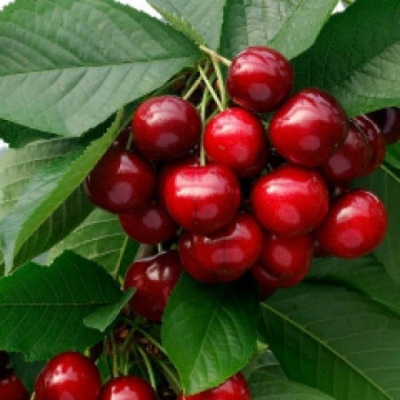
- Authors: Ukrainian selection
- Growth type: medium-sized
- Appointment: for fresh consumption
- Tree height, m: 3,5-4
- Crown: narrow, rounded, not thickened
- Fruit size: medium or large
- Fruit weight, g: 7-9
- Fruit color: dark red, almost black when fully ripe
- Pulp color : ruby
- Pulp (consistency): juicy
Sweet cherry Maiskaya is a variety that attracts gardeners with tasty fruits and frost resistance. It is worth considering in more detail the main characteristics of the tree and the features of its cultivation.
Breeding history
Ukrainian breeders were engaged in breeding May cherry, who managed to get a winter-hardy variety available for planting in the northern regions.
Description of the variety
Cherry Maiskaya is a medium-sized tree, reaching a height of 3.5-4 meters. Main characteristics:
sprawling sprawling crown;
large dark green leaves with jagged edges;
white long flowers, collected in inflorescences of 2-3 pieces.
The average width of the cherry leaf plate is 8 cm, the length reaches 15 cm. The tree is actively developing and bears fruit already 2-3 years after planting.
Fruit characteristics
Mayskaya cherry fruits can boast of large sizes. The average berry weight is 7-9 g. Characteristics:
the skin is dense;
color - dark red;
the pulp is juicy, ruby color;
the bone is small, easily detached.
Plus berries of a popular variety in high transportability and long shelf life. Cherry fruits are suitable for fresh use and for making various jams and preserves.
Taste qualities
Tasters rate the Maiskaya cherry taste at 4.5, which is a pretty good result. The berries are distinguished by a sweet taste with a slight sourness, and give off a pleasant aroma when ripe.
Ripening and fruiting
The tree begins to bear fruit in the second or third year after planting. Basically, the period of fruit formation falls on June-July, at the beginning of August it is already possible to harvest. It should be noted that ripening times may vary depending on the region and climatic conditions.

Yield
On average, 45-55 kg of fruit can be harvested from one tree.
Self-fertility and the need for pollinators
The variety is partially self-fertile. Planting a tree next to other varieties of cherries: Dzherelo, Rannyaya Duki or Melitopol'skaya early will help ensure a high yield.
Growing and care
Achieving high yields will help the correct approach to cultivation and care. Basic recommendations.
It is recommended to plant Mayskaya cherries on flat or slightly elevated areas, illuminated by the sun, where there are no drafts.
The water table must be deep to prevent root rot. Otherwise, it will be necessary to provide for a drainage system.
When choosing a seedling, preference should be given to two-year-old trees with a developed root system and no defects on the bark and leaves.
Planting is best done in the spring. The southern regions can plant the variety in the fall before the onset of cold weather.
The planting scheme is usual, care also includes standard activities.
Watering. Cherry Maiskaya is undemanding to abundant watering, however, during a drought period, it is worth increasing the volume to 1.5-2 buckets, which will be introduced into the ground 2-3 times a week.
Mulching.A necessary procedure that prevents stagnation of moisture and death of roots, as well as saturates the soil with oxygen.
Weeding. It is necessary to get rid of weeds so that the cherries grow actively and form juicy fruits.
Top dressing. Fertilizers should be applied in the third year after planting during flowering, fruiting and before the temperature drops.
Pruning. Responsible for the formation of the crown and the elimination of deformed, old or withered shoots.
Irregular watering, untimely fertilization or pruning will lead to a decrease in the percentage of crop survival and a deterioration in the quality of the crop.




Disease and pest resistance
The Mayskaya cherry variety has a strong immunity that protects the tree from diseases, but does not stop pests such as aphids, elephants, winter moths.
Timely and preventive treatment with special formulations will help to prevent the attack of pests.

Requirements for soil and climatic conditions
May cherry is frost-resistant, which is why it is in such demand among gardeners. At low temperatures, the tree will not die, but the harvest will be poor. But drought for the variety will be death, as well as an abundance of moisture.
































































